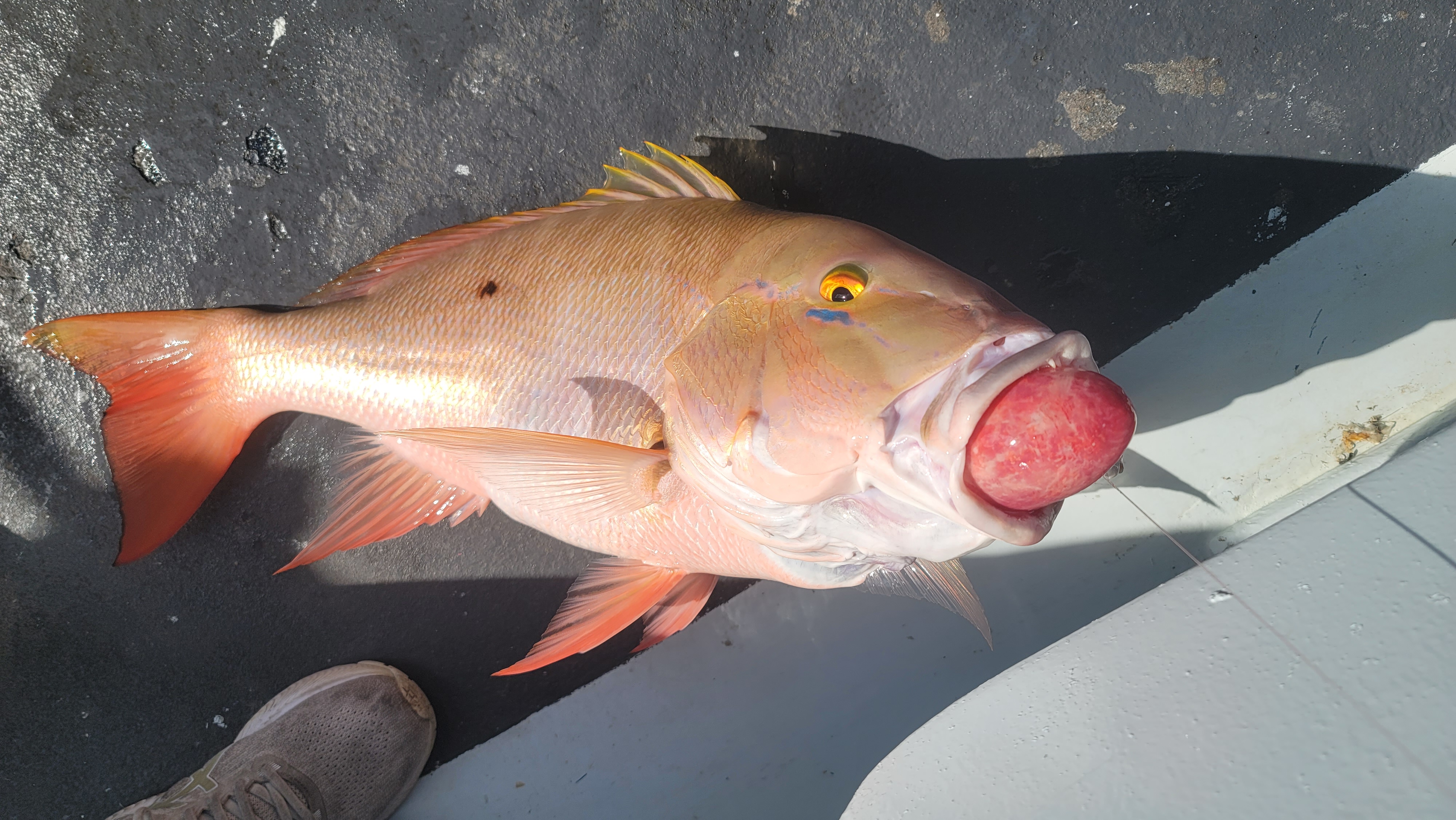Best Fishing Practices WORK!
Earlier this year, a group of Florida Sea Grant Extension Agents and Research Scientists hosted a fishing trip for local fishers in Miami-Dade County. This trip was part of a multi-state reef fish extension project. The goal of the trip was to communicate best fishing practices to newer and more experienced anglers alike. The trip was funded by the project and allowed participants to fish for free.
 Florida’s fisheries are very well-managed by the Florida Fish and Wildlife Conservation Commission (FWC) and the South Atlantic Fisheries Management Council (SAFMC). Regulations exist that set size limits, catch limits, and seasonal closures for both reef fish and pelagic species. This means that fishers may end up catching a fish that they have to release back into the water. While this seems like a great idea in theory, the reality is that a great deal of reef fish do not survive the release, resulting in their mortality (death). This is largely due to a condition called barotrauma, or “pressure injury,” which is caused by expansion of gases in the fish’s swim bladder expanding on their ascent. This gas expansion can result in popeye, bubbly scales, distended anus/intestines, and the general inability of the fish to return to depth on its own. Both state and federal regulations now require barotrauma mitigation tools to be not only on board, but readily available.
Florida’s fisheries are very well-managed by the Florida Fish and Wildlife Conservation Commission (FWC) and the South Atlantic Fisheries Management Council (SAFMC). Regulations exist that set size limits, catch limits, and seasonal closures for both reef fish and pelagic species. This means that fishers may end up catching a fish that they have to release back into the water. While this seems like a great idea in theory, the reality is that a great deal of reef fish do not survive the release, resulting in their mortality (death). This is largely due to a condition called barotrauma, or “pressure injury,” which is caused by expansion of gases in the fish’s swim bladder expanding on their ascent. This gas expansion can result in popeye, bubbly scales, distended anus/intestines, and the general inability of the fish to return to depth on its own. Both state and federal regulations now require barotrauma mitigation tools to be not only on board, but readily available.
Working with local charter company the Reward Fleet, this reef fishing trip focused on proper barotrauma mitigation utilizing two techniques: venting and descending. 14 anglers with 2-50 years of experience participated and worked hand-in-hand with Florida Sea Grant faculty to practice these techniques. Throughout the day, the anglers caught and successfully released:
- Mutton snapper
- Blueline tilefish
- Vermillion snapper
- Snowy grouper
 The trapped gas in the swim bladder was vented using a hollow needle. Fish were also descending back to depth using a rod and reel rigged up with a tool called a Seaqualizer, which clips onto the fish’s lip and releases automatically when it reaches the pre-set depth.
The trapped gas in the swim bladder was vented using a hollow needle. Fish were also descending back to depth using a rod and reel rigged up with a tool called a Seaqualizer, which clips onto the fish’s lip and releases automatically when it reaches the pre-set depth.
Verbal feedback from the participants indicated a high level of knowledge gained and willingness to employ the techniques when fishing on the reef. All anglers went home happy, either with a fresh fish to eat for dinner or the satisfaction of knowing that their released fish made it back to the bottom to continue their life cycle.
These experiential style learning opportunities produce results. We know that it is one thing to read about certain phenomena and another thing to try it and witness the outcomes. This model successfully demonstrated the relevance of best fishing practices and the adoption of these practices for newer and experienced anglers alike.


 Florida’s fisheries are very well-managed by the Florida Fish and Wildlife Conservation Commission (FWC) and the South Atlantic Fisheries Management Council (SAFMC). Regulations exist that set size limits, catch limits, and seasonal closures for both reef fish and pelagic species. This means that fishers may end up catching a fish that they have to release back into the water. While this seems like a great idea in theory, the reality is that a great deal of reef fish do not survive the release, resulting in their mortality (death). This is largely due to a condition called barotrauma, or “pressure injury,” which is caused by expansion of gases in the fish’s swim bladder expanding on their ascent. This gas expansion can result in popeye, bubbly scales, distended anus/intestines, and the general inability of the fish to return to depth on its own. Both state and federal regulations now require barotrauma mitigation tools to be not only on board, but readily available.
Florida’s fisheries are very well-managed by the Florida Fish and Wildlife Conservation Commission (FWC) and the South Atlantic Fisheries Management Council (SAFMC). Regulations exist that set size limits, catch limits, and seasonal closures for both reef fish and pelagic species. This means that fishers may end up catching a fish that they have to release back into the water. While this seems like a great idea in theory, the reality is that a great deal of reef fish do not survive the release, resulting in their mortality (death). This is largely due to a condition called barotrauma, or “pressure injury,” which is caused by expansion of gases in the fish’s swim bladder expanding on their ascent. This gas expansion can result in popeye, bubbly scales, distended anus/intestines, and the general inability of the fish to return to depth on its own. Both state and federal regulations now require barotrauma mitigation tools to be not only on board, but readily available. The trapped gas in the swim bladder was vented using a hollow needle. Fish were also descending back to depth using a rod and reel rigged up with a tool called a Seaqualizer, which clips onto the fish’s lip and releases automatically when it reaches the pre-set depth.
The trapped gas in the swim bladder was vented using a hollow needle. Fish were also descending back to depth using a rod and reel rigged up with a tool called a Seaqualizer, which clips onto the fish’s lip and releases automatically when it reaches the pre-set depth.